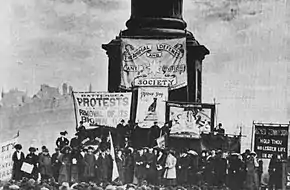 A demonstration on 19 March 1910 in Trafalgar Square, London, in support of the Brown Dog. The society's banner can be seen on Nelson's Column in the background. | |
| Formation | 1903 |
|---|---|
| Founders |
|
| Dissolved | 1971 |
The Animal Defence and Anti-Vivisection Society (ADAVS) was an animal rights advocacy organisation, co-founded in England, in 1903, by the animal rights advocates Lizzy Lind af Hageby, a Swedish-British feminist, and the English peeress Nina Douglas-Hamilton, Duchess of Hamilton.[1]
History
It was based for many years at Animal Defence House, 15 St James's Place, London, and ran a 237-acre animal sanctuary at Ferne House near Shaftesbury, Dorset, an estate owned by the Duke and Duchess of Hamilton.[2]
The Animal Defence and Anti-Vivisection Society's executive council included Alice Drakoules who was a lifelong campaigner for animal welfare and a keen supporter of the society. She helped the society campaign for licensed slaughterhouses, humane slaughter and for an end to performing animals.[3]
The society came to widespread attention during the Brown Dog affair (1903–1910), which began when Lind af Hageby infiltrated the vivisection in University College London of a brown terrier dog. The subsequent description of the experiment in her book, The Shambles of Science (1903) – in which she wrote that the dog had been conscious throughout and in pain – led to a protracted scandal and a libel case, which the accused researcher won. The affair continued for several years, making a name both for Lind af Hageby and for the society.[1]
The society was associated with Hageby's International Humanitarian Bureau.[4] It published The Anti-Vivisection and Humanitarian Review in 1929 and Progress Today: The Humanitarian and Anti-Vivisection Review in the 1930s.[4]
Following Lind af Hageby's death in December 1963, the society's assets were transferred to a trust, The Animal Defence Trust, which continues to offer grants for animal-protection projects.[5]
NC State University Libraries holds a large collection of pamphlets from the Animal Defence and Anti-Vivisection Society.[6]
Selected publications
See also
References
- 1 2 Kean, Hilda. "The 'Smooth Cool Men of Science': The Feminist and Socialist Response to Vivisection", History Workshop Journal, 1995, 40: 16–38.
- ↑ Smith, Andy. "Press dynasty is coming home from exile to a '£6m' mansion", The Observer, 13 June 1999.
- ↑ Kean, Hilda. (2004-09-23). "Drakoules [née Lambe; other married name Lewis], Alice Marie (c. 1850–1933), humanitarian and campaigner for animal welfare". Oxford Dictionary of National Biography. Retrieved 30 Dec. 2017, see link
- 1 2 "The International Humanitarian Bureau". lonsea.de. Retrieved 14 January 2022.
- ↑ "History". The Animal Defence Trust. Retrieved 28 February 2020.
- ↑ Animal Defence and Anti-Vivisection Society. d.lib.ncsu.edu. Retrieved 8 December 2023.
Further reading
- Gålmark, Elisabeth Lisa. Shambles of Science, Lizzy Lind af Hageby & Leisa Schartau, anti-vivisektionister 1903-1913/14. Stockholm University, 1996.
- Gålmark, Elisabeth Lisa. "Women Antivivisectionists, The Story of Lizzy Lind af Hageby and Leisa Schartau," in Animal Issues. 2000, Vol 4, No 2, pp. 1–32.
- Kean, Hilda. Animal Rights: Political and Social Change in Britain since 1800. Reaktion Books, 1998.
- Lansbury, Coral. The Old Brown Dog: Women, Workers, and Vivisection in Edwardian England. University of Wisconsin Press, 1985.
- Mason, Peter. The Brown Dog Affair. Two Sevens Publishing, 1997.